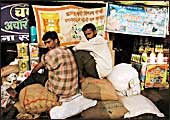 |
| A Barista outlet: Storm in
a coffee-cup |
Barista
Coffee' Company's (BCC) cup of woes continues to brim over. The
pioneering coffee chain has been besieged with problems, starting
with a business model that went haywire, followed by the exit of
its original promoter, Turner Morrison, and entry of Sterling Group's
C. Sivasankaran early this year. In between, it has seen two of
its CEOs go: the first being Ravi Deol (the man blamed for Barista's
losses) in May 2003 and the second his successor, Yogesh Samat,
who resigned early this month. To top it all, there are strong rumours
that Tata Coffee (which owns 34.3 per cent of the company's equity)
may want out too.
Though Tata Coffee
has denied sell-off reports, the market is abuzz that international
coffee chain Starbucks has been sounded out by the Tata Group. But
the moot point is, would Starbucks be interested? Unlikely. This
business is all about brands. Why would Starbucks want to trade
in its own equity for Barista's in India? A cafe's competency is
location, and here too there are enough of high-street locations
still available, so Barista again can offer very little to Starbucks.
It has been Starbucks' philosophy to enter new markets, such as
China, which it did in 2002, on its own steam or at best with a
super-franchisee a la McDonald's in India. And it is here that Barista
can, hypothetically, fit in nicely as the back-end company running
the Starbucks brand in India. An Indian coffee chain brand would
have been killed, but investors would have salvaged some value.
-Shailesh Dobhal
A
Costly Game To Play
It costs advertisers a hell of a lot of money
to buy cricket. So why is no one complaining?
 |
At close to Rs 11-12-crore
a day, the recent auction of four-year (108 days) live telecast
rights of international cricket matches in India by the Board of
Control for Cricket in India (BCCI), raises some fundamental questions.
Like, has cricket become too expensive for both broadcasters as
well as advertisers? Ever since Sony Television's Max bid $225-million
(Rs 1,097-crore at 2002 exchange rates) for the International Cricket
Council rights from 2002 to 2007, there has been an upward spiral
in acquisition costs, with the current BCCI bids drawing $260-million
(1,214-crore) from Zee, and $230-million (Rs 1,074-crore) from ESPN-Star
Sports. "The inflation in cricket advertising costs is largely
because of irrational bidding by competing broadcasters," says
C.V.L. Srinivas, Managing Director of Group M media-buying company,
Maxus. Why isn't anyone complaining? "For cricket, viewership
in India is absolute and confirmed," says Kunal Dasgupta, MD,
SET India. Advertisers agree. There already are some 1,600 brands
riding on cricket and their number is growing 35 per cent year-on-year,
compared to 20 per cent for overall TV advertising. Not surprisingly,
Zee expects Rs 800 crore of profits from the BCCI deal.
-Shailesh Dobhal
''BPOs And Net Phone Networks
Are The Latest Targets''
Every
year, dozens of big and small computer viruses attack networks worldwide.
Most cause temporary and minor damage, but some end up crippling
networks. Like MSBlast, which hit the networks last year and immediately
threw it infrastructure of companies out of gear. One of the companies
that's made a billion-dollar business out of protecting computers
is McAfee. Recently, its Chairman and CEO,
George Samenuk, was in India and spoke to BT's Venkatesha
Babu on emerging industry trends. Excerpts:
How do anti-virus companies sell without
coming off as zealots scaring people into buying their technology?
(Smiles) Yes, aren't we a bit like the insurance
people? But enterprises are realising the kind of losses inflicted
by business opportunity lost because of viruses. So an investment
in protecting oneself is understandable.
The industry is seen as offering merely
anti-virus and firewall protection, and not being pro-active enough.
What is your defence?
That is a very simplistic way of looking at
things. McAfee has moved beyond being reactive to being a pro-active
player, offering services like intrusion detection and intrusion
prevention. We try to keep ourselves a step ahead of the bad guys,
but with several hundred viruses coming out all the time it is a
tough thing to do. People don't appreciate that.
How does India fit into McAfee's global
plans?
We have been in India for the past couple of
years. This visit is related to our setting up a research lab, which
will work on software to detect and prevent viruses, SPAM and worms
coming out all the time. We have 400 people working in India, which
is more than 10 per cent of our global workforce of around 3,100
people. We have a technical support centre in India, which supports
our global customers. In some of our recent releases, the Indian
centre has contributed nearly a third to product development.
Is the Indian market (estimated at Rs 240
crore) for virus protection growing?
The Indian market is growing significantly.
With the number of BPOs present that work 24x7, any attack can be
devastating. Indian BPOs are signing up with us. Also with a number
of IP telephony networks increasing in enterprises, demand for our
products and services in India are also going up significantly.
The BPO industry and the phone networks are the latest targets.
Should It Be Stock, Or Soya?
Volumes in commodities trading have touched
Rs 1,500 crore. And they're rising fast.
 |
| Commodities trading: Looking
up |
After
a bumpy start, commodity markets in India have finally started looking
up. And the combined volume of the three national commodity exchanges
(National Commodity and Derivatives Exchange (NCDEX), Mumbai, Multi
Commodity Exchange (MCX), Mumbai and National Multi Commodities
Exchange (NMCE), Ahmedabad has already reached levels of Rs 1,500
crore. For a market that's only just opened up, that compares well
with average daily stockmarket volumes of Rs 13,000 crore. Stockbrokers
who've ventured into this virgin territory are obviously ecstatic.
"It has already reached 25-30 per cent of our stockmarket volumes,"
says Satish Menon, coo, Geojit Securities.
Gold and silver are contributing the majority
of volume. Not surprising because these are standard commodities
and serve as international currency. But transactions in other commodities
(especially agricultural ones) are increasing rapidly. Products
like guar seeds (13 per cent), soya (12 per cent), and rubber (4
per cent) are among the high-volume generators. More importantly,
retail participation in these commodities is also very high. That's
good news because it means the real beneficiaries-farmers and users
of these agricultural products- have finally cottoned onto commodities.
-Narendra Nathan
|
